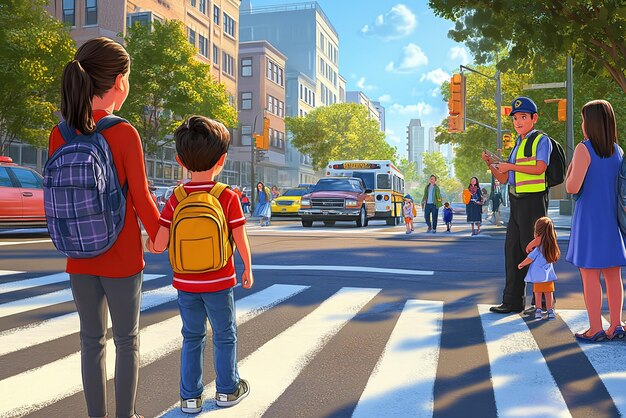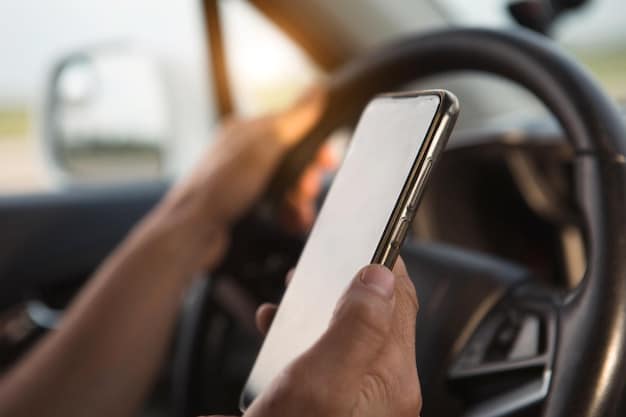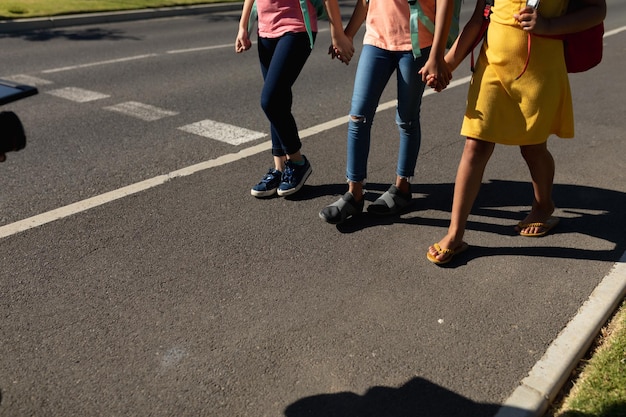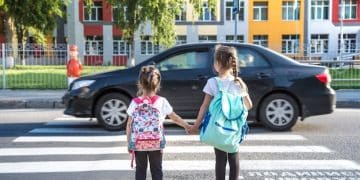School Zone Safety: A Parent’s Guide to Safe Walking Routes

Ensuring children walk to school safely involves comprehensive strategies, including well-maintained infrastructure, vigilant crossing guards, and thorough pedestrian education, forming a collaborative approach between parents, schools, and communities to minimize risks and promote safe commuting habits.
Are your children walking to school? Ensuring their safety on those walks is paramount. This comprehensive guide, rooted in the principle of Are Your Children Walking to School Safely? A Comprehensive Guide to School Zone Pedestrian Safety, aims to equip parents, schools, and communities with the knowledge and tools to create secure walking routes for students.
Understanding the Risks: School Zone Dangers
Walking to school offers numerous benefits, from physical exercise to fostering independence. However, school zones present unique dangers that parents and educators must address proactively. Understanding these risks is the first step towards ensuring student safety.
Traffic Congestion
One of the most significant risks in school zones is heavy traffic congestion, especially during drop-off and pick-up times. The presence of numerous vehicles, often driven by distracted or hurried parents, can lead to accidents.
Distracted Driving
Distracted driving, including texting, talking on the phone, or adjusting navigation systems, poses a significant threat to pedestrians. Drivers who aren’t fully attentive to their surroundings are more likely to miss seeing children crossing the street or walking along the sidewalk.
- Implement stricter enforcement of traffic laws in school zones.
- Encourage parents to carpool or use alternative transportation methods.
- Designate specific drop-off and pick-up zones away from high-traffic areas.

By recognizing and addressing these risks, we can take concrete steps to protect our children as they walk to school. Creating a safer environment requires a collaborative effort from parents, schools, and the community.
Assessing Your Child’s Walking Route: A Step-by-Step Guide
Before allowing your child to walk to school, it’s essential to thoroughly assess their walking route. This involves identifying potential hazards, evaluating safety measures, and teaching your child how to navigate the route safely. A systematic approach can greatly reduce risks and provide peace of mind.
Identify Potential Hazards
Begin by walking the route yourself, noting any potential dangers such as busy intersections, lack of sidewalks, construction zones, or areas with poor visibility. Pay attention to traffic patterns and the presence of crosswalks and crossing guards.
Evaluate Safety Measures
Assess the existing safety measures along the route, including traffic signals, crosswalks, pedestrian signs, and the presence of crossing guards. Determine if these measures are adequate and well-maintained. Are the traffic signals timed appropriately for pedestrians? Are crosswalks clearly marked and visible?
- Walk the route with your child, teaching them how to identify and avoid hazards.
- Practice crossing the street at designated crosswalks, emphasizing the importance of looking both ways before crossing.
- Establish a “buddy system” with other parents, allowing children to walk together for added safety.
By following these steps, you can create a safer walking route for your child and empower them with the knowledge and skills to navigate the journey independently.
The Role of Schools in Promoting Pedestrian Safety
Schools play a crucial role in promoting pedestrian safety by implementing comprehensive safety programs, educating students about road safety, and collaborating with local authorities to improve infrastructure. A proactive approach from schools can significantly enhance the safety of students walking to and from school.
Safety Education Programs
Schools should incorporate pedestrian safety education into their curriculum, teaching students about traffic laws, safe walking practices, and hazard recognition. These programs should be age-appropriate and interactive, using engaging methods such as games, simulations, and guest speakers.
Collaborating with Local Authorities
Schools should work closely with local authorities, such as the police department and transportation agencies, to identify and address safety concerns in school zones. This collaboration can lead to improvements in infrastructure, increased traffic enforcement, and the implementation of safety initiatives.

- Establish a school safety patrol program, training older students to assist younger students at crosswalks and busy intersections.
- Organize “Walk to School” days to promote physical activity and raise awareness about pedestrian safety.
- Conduct regular safety audits of school zones, identifying and addressing potential hazards.
By taking these steps, schools can create a safer environment for students walking to and from school, fostering a culture of safety and responsibility.
Empowering Children with Pedestrian Safety Skills
Equipping children with pedestrian safety skills is essential for their well-being and independence. Teaching them how to navigate roads safely, recognize hazards, and make informed decisions can empower them to protect themselves in various traffic situations. This education should be ongoing and reinforced regularly.
Teaching Safe Crossing Techniques
One of the most critical skills is teaching children how to cross the street safely. Emphasize the importance of stopping at the curb, looking left, right, and left again before crossing, and making eye contact with drivers to ensure they see you. Practice these techniques repeatedly until they become second nature.
Recognizing Traffic Signals and Signs
Children should be able to recognize and understand traffic signals and signs, including pedestrian signals, crosswalk signs, and stop signs. Teach them what each signal means and how to respond appropriately. Explain that traffic signals are there to help them cross safely.
Empowering children with these skills not only enhances their safety but also fosters a sense of responsibility and awareness, contributing to a safer community for everyone.
Community Involvement: Creating Safer School Zones Together
Creating safer school zones requires the collective effort of the entire community. Parents, residents, local businesses, and community organizations all have a role to play in ensuring the safety of students walking to and from school. A collaborative approach can lead to significant improvements and a more secure environment for children.
Parent Patrol Programs
Parents can volunteer to patrol school zones during drop-off and pick-up times, assisting crossing guards, monitoring traffic, and reminding drivers to obey traffic laws. This visible presence can deter speeding and distracted driving, making the area safer for pedestrians.
Neighborhood Watch Initiatives
Neighborhood watch programs can extend their focus to include school zone safety, monitoring suspicious activity, reporting hazards, and advocating for safety improvements. By working together, residents can create a stronger sense of community and protect children walking to school.
Leveraging Technology for Enhanced Safety
Technology offers various tools and solutions that can enhance pedestrian safety in school zones. From mobile apps to smart infrastructure, leveraging technology can provide real-time information, improve visibility, and promote safer behaviors among drivers and pedestrians alike. Embracing these innovations can contribute to a more secure environment for students.
Mobile Apps for Pedestrian Safety
Several mobile apps are designed to enhance pedestrian safety, providing features such as real-time traffic alerts, safe walking route recommendations, and emergency contact options. These apps can empower students and parents with valuable information and resources to navigate school zones safely.
Smart Infrastructure Solutions
Smart infrastructure solutions, such as smart crosswalks with pedestrian detection systems, can significantly improve safety in school zones. These systems use sensors and cameras to detect pedestrians waiting to cross the street and activate flashing lights or audible warnings to alert drivers. This technology can enhance visibility and reduce the risk of accidents.
| Key Point | Brief Description |
|---|---|
| 🚶Route Assessment | Evaluate the walking path for hazards and safety measures. |
| 🚦Safety Education | Teach kids about traffic signals, signs, and safe crossing. |
| 🤝Community Role | Parents, schools, and businesses improve safety. |
| 📱Tech Use | Apps and infrastructure enhance pedestrian safety. |
FAQ
▼
The primary dangers include traffic congestion, distracted drivers, lack of safe crossing points, and poor visibility due to parked cars or landscaping. Address these issues directly to ensure children’s safety.
▼
Parents can walk the route, note hazards, evaluate traffic signals and signs, and identify safe crossing points. Involve your child in the process to teach them hazard recognition.
▼
Schools implement safety education programs, collaborate with local authorities, organize “Walk to School” days, and establish safety patrol programs. These initiatives foster a culture of safety.
▼
Teach them to stop at the curb, look left, right, and left again, and make eye contact with drivers before crossing. Practice these steps regularly and reinforce their importance daily.
▼
Communities can organize parent patrols, participate in neighborhood watch initiatives focused on school zones, and advocate for infrastructure improvements, like better lighting and signage.
Conclusion
Ensuring the safety of children walking to school requires a multifaceted approach involving parents, schools, communities, and technology. By understanding the risks, assessing walking routes, empowering children with safety skills, and fostering community involvement, we can create safer school zones and protect our children on their daily journey to and from school.





